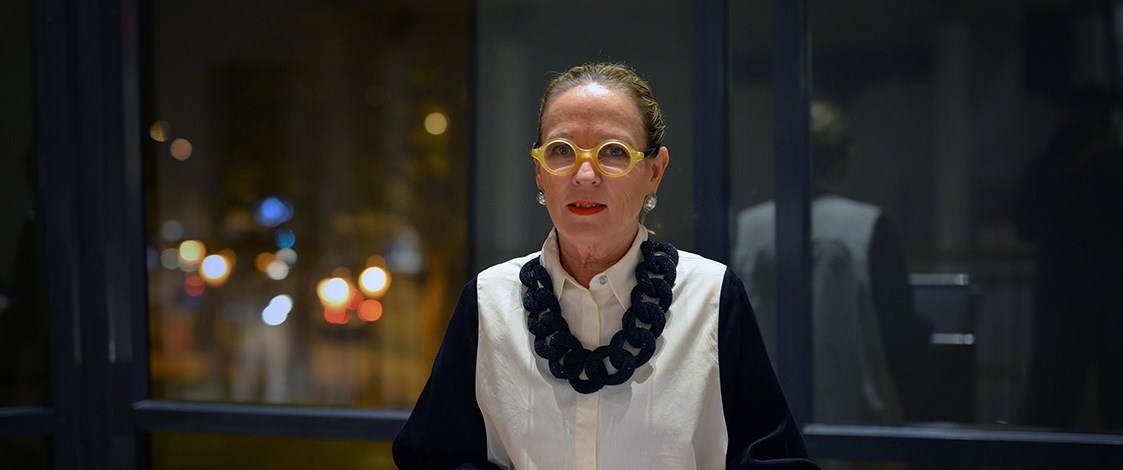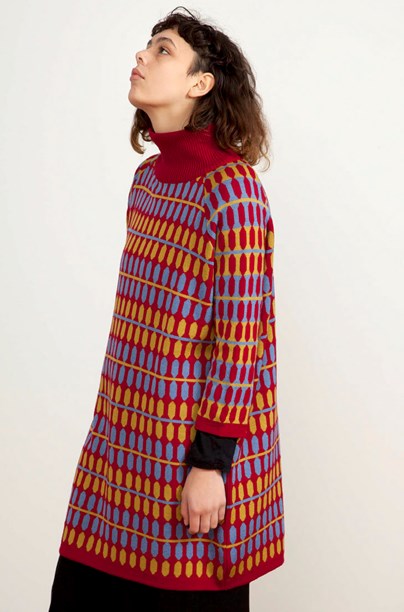Stories
Marie Strauss & DADA
2008- (label)

The brainchild of designer and artist Marie Strauss, DADA, and its flagship boutique DADA Manifesto, emerged on the Dunedin scene in 2008 with a fanfare of brilliant colour and dramatic accessories. In a town typically associated with New Zealand Southern Gothic and edgy streetwear, Marie’s creations, marketed under the labels DADA Vintage (2008-2014) and DADA Collection, quickly gained a cult following among this city’s savvy citizens who sought out her shop as a fashion destination.
With the advent of DADA KNIT in 2017/18, stocked in boutiques across New Zealand, the brand achieved national visibility, establishing Marie as a Kiwi designer with a unique eye.

DADA KNIT, A/W 2018/19. Photo by Justin Spiers, courtesy Dada Manifesto.
Marie initially trained as an actress and then as painter and ceramicist and holds a MFA (2010) from the Otago Polytechnic/Te Kura Matatini ki Otago. Immigrating to New Zealand from South Africa with her husband and three children in 1993, she currently divides her time between her working farm (in North Taieri) and her boutique in Dunedin on Moray Place. More of a gallery than a commercial venue, this space boasts a curated collection that includes her own brand as well those of other New Zealand makers; international labels; cult brands such as Walter Van Beirendonck and Survival of the Fashionest (SOFT); and works by Dunedin artists such as Madeleine Child, Philip Jarvis and Andrea Muggeridge. She embraces fashion design in all its aspects and regularly participates in iD Dunedin Fashion Week.
DADA Vintage, iD Dunedin, 2014. Photo courtesy Chris Sullivan, and Dada Manifesto.
Marie frequently remarks, "For me ... to cook, or to be involved in fashion, to make choices about knitwear, or colours [gives me] the same satisfaction as making a painting, a pot." Her impeccably tailored apparel juxtaposes unexpected textures, colours and fabrics that complement the clean lines of her designs, reflecting her life-long love of European art and style. Marie reiterates: "My voice is in everything I do." She is fond of saying, a kind of mantra, "What you wear is part of art and art is part of life."
Her experience in New Zealand has been a happy one. In her own words, "The moment that I had the shop, things just settled down." Marie frequently comments that it is easier to sell clothes than "art". Her relations with the fashion industry are, not unexpectedly, unconventional. She does not produce a new line with each season, but operates through accretion, renovating patterns through subtle variations in cut and texture. The fabrics themselves are sourced internationally with a coat, for example, often made from a single unique piece of cloth brought back from Europe in a suitcase. She frequently claims that her clothes are not about fashion, meaning the fashion system with its cult of the new and of brand visibility. Buying a DADA garment is a long-term investment.
The name 'DADA Manifesto' itself refers to the European post-World War I avant-garde art movement that criticised 20th century society and, as Marie explains, "embraced the absurd". "I am not actually going to the dark side," she confides reassuringly. She seeks joy in the everyday. Her activities as a designer and a stylist constitute a form of resistance to the anonymity and conformism of corporate culture, an activism in which we are all invited to participate whether it be through our choice of a hat, a scarf, a bangle - or of a magnificently tailored coat in a rich, and rare fabric.
DADA Collection, iD Dunedin, 2019. Photo courtesy Chris Sullivan and Dada Manifesto.
DADA Collection and DADA KNIT emphasise traditions of tailoring and colour that developed in Europe in the early 20th century associated with the Bauhaus movement. Inspired by Coco Chanel and the New Woman of the 1920s, Marie’s thoughtfully designed, meticulously finished garments, and her colourful geometrically patterned knitwear, appeal to those who look for polish and ease in their outfits, largely women who love style but see themselves as outside on-trend fashion with its ephemeral whims and often impractical fancies. A few brave men also occasionally incorporate a DADA KNIT jersey and scarf, or a DADA Collection long, wool belted trench-coat into their wardrobes, appreciating the warmth, comfort and timelessness of her garments. Marie herself encourages an approach to dress that challenges the norms of age, class, and gender while promoting a sense of fashion that moves beyond the excesses of conspicuous consumption. Her self-belting tunics, paired with her black wool trousers and her neatly cut dark blazer lined with a well-chosen and distinctive fabric, flatter serious-minded women of all ages. These same tunics serve equally well as sleek little dresses worn over black tights for those who are young or young at heart.
Her small runs, produced locally, often using fabric short-ends and vintage findings, her preference for natural fibres, and her reliance on Dunedinites as customers, mean that she participates in the move towards more sustainable practices preferred by ecologically conscious Antipodeans today - practices that support the region in which she lives. But most of all, Marie’s creations never go out of style, retaining their freshness and attractiveness from year to year. Like the gorgeous 1940s coats that 1960s young hippies found in their mothers’ and grandmothers’ closets, and continue to treasure today, Marie’s designs will survive the decades.
Text by Hilary Radner. Banner image of Marie Strauss by Justin Spiers, © Dada Manifesto.
Last published April 2019.